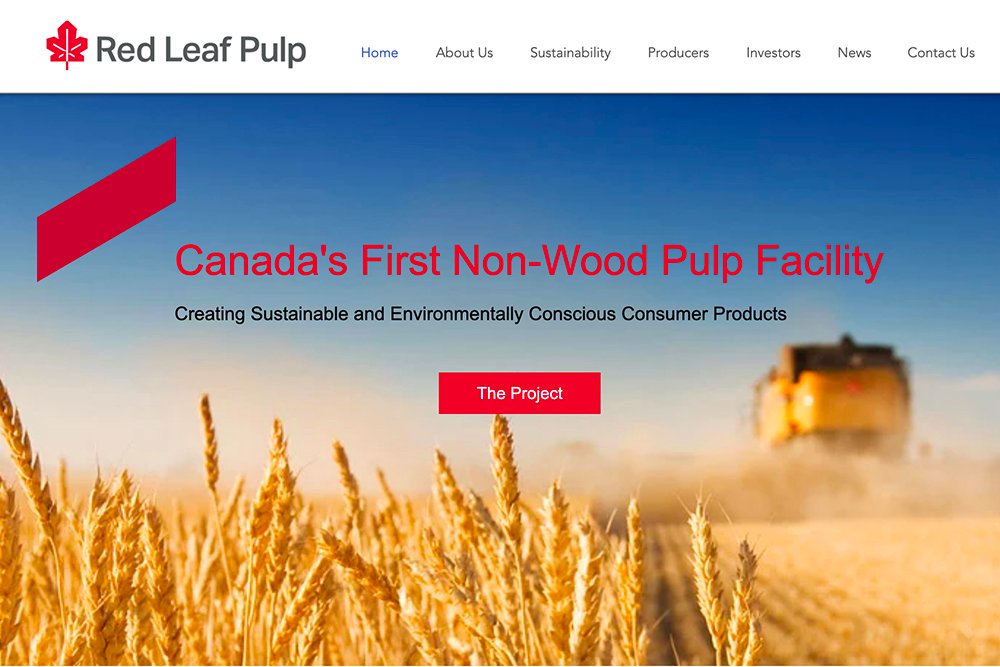Proposed pulp mill in Sask. would use straw

Producers remind company that straw residue plays an important nutritional role in fields and that supply may be limited
Red Leaf Pulp Ltd. has announced the first of what could be four wheat straw pulp mills in Saskatchewan.
Construction of a $350-million facility is expected to begin next year in Regina with operation to begin in the second half of 2023.
It will produce about 182,000 tonnes of pulp each year for sale into the paper and packing market.
Chief executive officer Martin Pudlas said Regina has a concentration of feedstock, good logistics and proximity to markets.
“All things considered for plant number one, Regina checked the boxes the best,” he said in an interview.
Red Leaf will contract from growers to feed its proprietary process. Bales of wheat and durum straw will be run through continuous pressure, Pudlas said, creating a market pulp similar to Canadian wood pulp.
“We will be providing a carbon-reduced feed material to converters that make tissue and towel, would make packaging material, or for moulded products to replace clamshell containers that would currently be made with Styrofoam,” Pudlas said.
He said straw contains less lignin than wood and requires less energy to separate the fibres. In turn, the carbon intensity associated with the pulp fibres is lower.
Red Leaf is based in Kelowna, B.C., and was established by Darby Kreitz, founder of Allnorth Consultants, a major engineering firm across North America that has designed and commissioned non-wood pulp mills in the U.S. and Europe.
“Given that common ownership, we’ve got significant technical capability in terms of designing and engineering and constructing the technology,” said Pudlas.
He said the fibre produced from wheat straw is similar to that of eucalyptus pulps from South America. However, he noted that land use in countries there has completely changed as eucalyptus forests were cloned for production.
The opportunity in Saskatchewan is to have better use of an existing resource and complementary revenue streams for growers.
Pudlas said Red Leaf prefers to compare wheat straw to wood, rather than flax.
Reception from growers has been positive, he said, and preference for contracts will be given to early participants.
Farmers will have to windrow their straw, rather than put it through a chopper, and bale it according to company standard size.
“From a grower perspective, any subsequent harrowing that has to be done today will not be required working with Red Leaf and we think we’ve got a very good and competitive pricing model,” he said.
Pudlas said if one compares the available feedstock to the wood pulp industry, the equivalent of two-thirds of the feedstock is sitting unused.
“That gives you an idea of the potential value creation that we see,” he said. “It’s really an opportunity for Canada as a whole to have enhanced utilization of resources that we’ve already got, and today, to be frank, are largely wasting.”
Daryl Fransoo, a Glaslyn-area farmer and chair of the Western Canadian Wheat Growers Association, said he and other farmers take issue with the term waste because straw residue contributes nutrients and soil organic matter.
That said, he believes farmers will look at selling straw if the price is right.
“I’m probably in the camp where there’s a price that I would sell it at,” he said. “It would depend on the fertilizer prices. If they were willing pay me way over what it’s worth fertilizer-wise, I would consider it.”
Fransoo said value-added or revenue streams for farmers are good, but farmers have also seen various straw plants come and go.
“With the new green mandate that our federal government has brought in it probably makes more economical sense and I think that’s why we’re seeing stuff like this,” he said.
Alberta Biobord is also planning a straw fibre MDF plant near Stettler, Alta.
Harvey Brooks, general manager of SaskWheat, said the organization was aware of Red Leaf’s plans early on. He said they did talk about the value of straw to producers and how often it could be taken off fields.
“I think they’re aware of the significant challenge of maintaining a solid supply chain for their raw product,” he said, adding each producer will make an individual decision.
“We do know that, however, producers would view this as something they might consider in terms of their straw management practices. To that extent and for the economy as a whole, it’s generally positive.”
Pudlas said interest is strong because of the lower carbon attributes of the project. Red Leaf also recently received a grant worth $395,000 from the Saskatchewan Advantage Innovation Fund.
Source: www.producer.com

